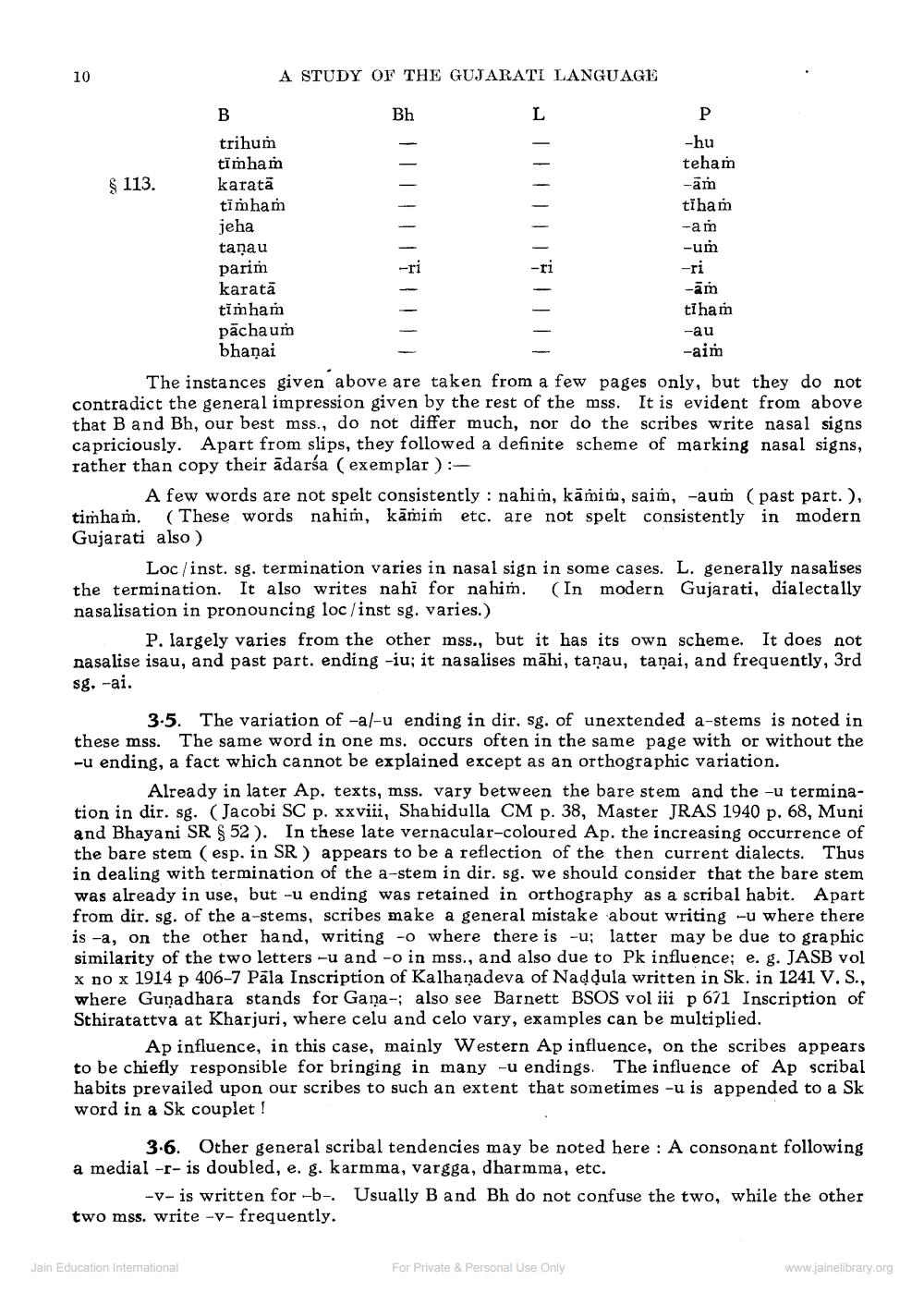________________
A STUDY OF THE GUJARATI LANGUAGE
P
trihum
-hu timham
teham $ 113. karatā
-am timham
tiham jeha
-am tanau
-um parim
-ri karata
am timham
tiham pāchaum
-au bhanai
-aim The instances given above are taken from a few pages only, but they do not contradict the general impression given by the rest of the mss. It is evident from above that B and Bh, our best mss., do not differ much, nor do the scribes write nasal signs capriciously. Apart from slips, they followed a definite scheme of marking nasal signs, rather than copy their ādarśa (exemplar )
A few words are not spelt consistently : nahim, kāmin, saim, -aum (past part.), timham. (These words nahim, kāmim etc. are not spelt consistently in modern Gujarati also )
Loc/inst. sg. termination varies in nasal sign in some cases. L. generally nasa lises the termination. It also writes nahi for nahim. (In modern Gujarati, dialectally nasalisation in pronouncing loc/inst sg. varies.)
P. largely varies from the other mss., but it has its own scheme. It does not nasalise isau, and past part. ending -iu; it nasalises māhi, tanau, tanai, and frequently, 3rd sg. -ai.
3-5. The variation of -al-u ending in dir, sg. of unextended a-stems is noted in these mss. The same word in one ms. occurs often in the same page with or without the -u ending, a fact which cannot be explained except as an orthographic variation.
Already in later Ap, texts, mss. vary between the bare stem and the -u termination in dir. sg. (Jacobi SC p. xxviii, Shahidulla CM p. 38, Master JRAS 1940 p. 68, Muni and Bhayani SR S 52). In these late vernacular-coloured Ap. the increasing occurrence of the bare stem (esp. in SR) appears to be a reflection of the then current dialects. Thus in dealing with termination of the a-stem in dir. sg. we should consider that the bare stem was already in use, but -u ending was retained in orthography as a scribal habit. Apart from dir. sg. of the a-stems, scribes make a general mistake about writing -u where there is -a, on the other hand, writing - where there is -u; latter may be due to graphic similarity of the two letters -u and -o in mss., and also due to Pk influence; e. g. JASB vol x no x 1914 p 406-7 Pāla Inscription of Kalha nadeva of Naddula written in Sk. in 1241 V. S.. where Gunadhara stands for Gana-; also see Barnett BSOS vol iii p 671 Inscription of Sthiratattva at Kharjuri, where celu and celo vary, examples can be multiplied.
Ap influence, in this case, mainly Western Ap influence, on the scribes appears to be chiefly responsible for bringing in many -u endings. The influence of Ap scribal habits prevailed upon our scribes to such an extent that sometimes -u is appended to a Sk word in a Sk couplet !
3.6. Other general scribal tendencies may be noted here : A consonant following a medial -r- is doubled, e. g. karmma, vargga, dharmma, etc.
-V- is written for -b- Usually B and Bh do not confuse the two, while the other two mss. write -v- frequently.
Jain Education International
For Private & Personal Use Only
www.jainelibrary.org




